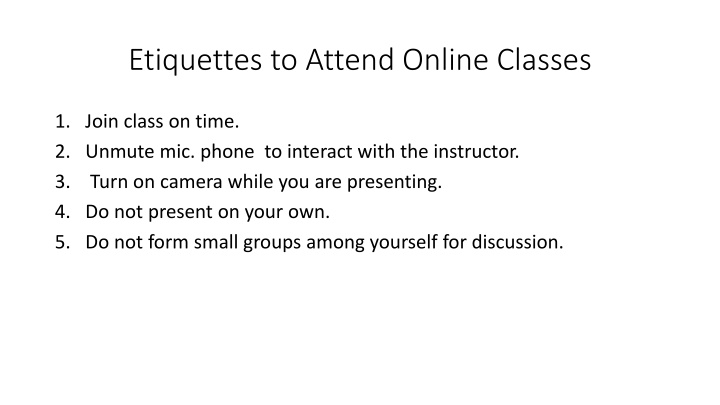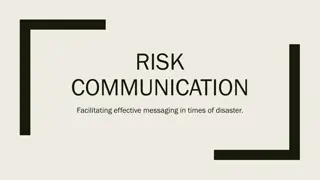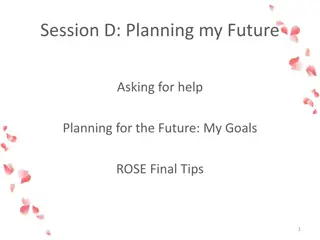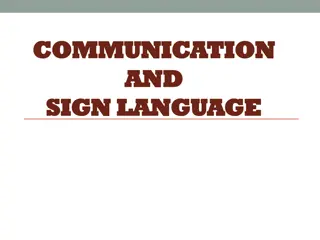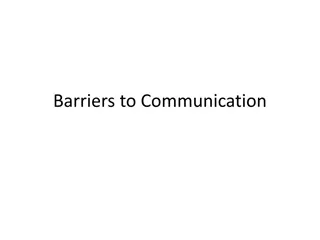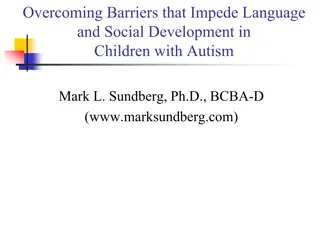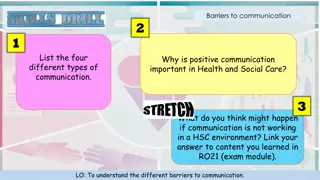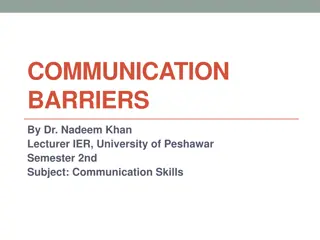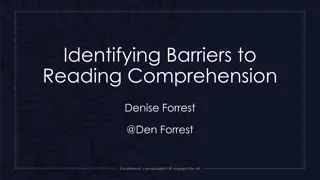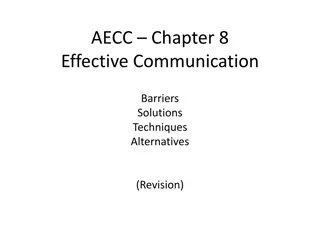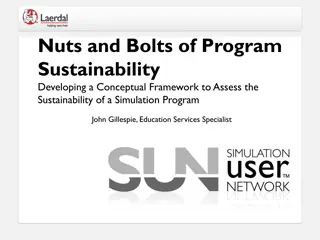Online Class Etiquettes and Overcoming Communication Barriers
Attending online classes requires following specific etiquettes like joining on time, muting/unmuting mic, turning on camera, and avoiding small group discussions. Understanding and overcoming communication barriers such as intra-personal, inter-personal, and organizational is essential for effective communication in any setting.
Uploaded on Sep 27, 2024 | 2 Views
Download Presentation

Please find below an Image/Link to download the presentation.
The content on the website is provided AS IS for your information and personal use only. It may not be sold, licensed, or shared on other websites without obtaining consent from the author.If you encounter any issues during the download, it is possible that the publisher has removed the file from their server.
You are allowed to download the files provided on this website for personal or commercial use, subject to the condition that they are used lawfully. All files are the property of their respective owners.
The content on the website is provided AS IS for your information and personal use only. It may not be sold, licensed, or shared on other websites without obtaining consent from the author.
E N D
Presentation Transcript
Etiquettes to Attend Online Classes 1. Join class on time. 2. Unmute mic. phone to interact with the instructor. 3. Turn on camera while you are presenting. 4. Do not present on your own. 5. Do not form small groups among yourself for discussion.
Communicative English Course Code: HSS-S101 Deepti Agarwal Instructor
Classification of Barriers Intra Personal Barriers: An individual becomes a barrier . Inter Personal Barriers: Either the sender or the receiver becomes a barrier . Organisational Barriers: Either the system, or individuals, groups becomes barriers.
Intra Personal Barriers/ Psychological/ Behavioral Wrong Assumptions Varied Perceptions Differing Backgrounds Wrong Inferences Blocked Categories Categorical thinking
Wrong Assumptions 1. The Sender or the receiver has fixed ideas. (rigid/ fixed) 2. The sender or the receiver doesn t have background knowledge/ context. Comments: you have joined in the middle of the conversation. 3. The sender or the receiver entertains certain false concepts.
For example: a. I have enough time for exam, I will start studying tomorrow. b. I am being perfectly logical and fair and everyone that disagrees with me is just plain stupid. Revised: I believe I have made a logical and rational point however there is always the other side to a coin (barrier free). a. My moral system is the social norm, if you don t agree with me, something is wrong with you. b. Things will work out. (General) Revised: we have a systematic plan for things to work out. a. Being in a relationship gives you the right of ownership of your partner. (oppressive, dominating, authoritative, restrictive) Revised: A good relationship works when each one gives space to the other. a. I can get a partner as long as I m smart and attractive and friendly b. Everyone is having an affair or cheating on their partner. c. All eyes are on you. (construct) d. I am important and I am right.
Varied Perceptions Each and every individual has different view points on a topic. Individuals having similar viewpoints are likely to be biased. Individuals having differing viewpoints are likely to be at loggerheads.
Differing Backgrounds Factors: Education Language Culture Environment Financial Status
Wrong Inferences Fact- Inference Confusion For example You have returned from a business trip and you find that two of your colleagues are absent. They do not turn up for several days. Since there is a recession on, you draw an inference that they have been laid off. The fact is that they have been promoted and sent to another department. When presenting any inference in the course of your work, you could use qualifiers such as evidence suggest or in my opinion to remind yourself and the receiver that this is not yet established as fact.
Closed Mind The expression closed mind refers to thinking tendency of the people that they know everything about the issue and therefore refuse to accept any further information on that topic. People who feel that they know it all are called Pansophists. This type of thinking can pose a major barrier, leading to failure in communication. In such instances, the receivers refuse information because of their know it all attitude . The clue to detect this barrier is the use of words like all, always, everybody, everything, every time and their opposites like none, never, nobody and nothing. To avoid this barrier use phrases like it appears to me or the evidence indicates . If your data is insufficient, it is better to admit that you are unaware of the rest of the information rather than stone walling. (obstruct with evasive/ ambiguous answers)
Blocked Categories We react positively to information only if it is in consonance with our views and attitudes. Conversely, when we receive information that does not conform to our personal views, habits and attitudes or appears unfavorable to us, we tend to react negatively or even disbelieve. People who are very rigid in their opinions may face problems in communicating effectively. For example one of your fellow students may think that only students of sc. are good at reasoning, such people fall into impervious categories because they may not be able to accept any deviation from their points of view.
Inter Personal Barriers Intrapersonal barriers stem from an individual s attitude or habits whereas Inter-personal barriers occur due to inappropriate transaction of words between two or more people.
LIMITED VOCABULARY During your speech, if you are at loss of words, your communication will be ineffective and you will leave a poor impression on your audience. The correct and accurate usage of words. If you have a varied and substantial vocabulary, you can create an indelible impression on your listeners.
INCONGRUITY OF VERBAL AND NON- VERBAL MESSAGES Ignoring non-verbal cues or misinterpreting them can result in the message being completely misunderstood. For example In a small speech a peer employee conveys the message that he is very delighted on the promotion of his colleague. However the expression on his face shows just the opposite of what he is saying.
Ways to resolve The stark difference between the verbal and non-verbal aspects of his communication leaves his listeners feel confused and puzzled. Your non-verbal cues should consistently match with your verbal message, adding to their effectiveness and enhancing your image as a competent and interesting communicator.
EMOTIONAL OUTBURST Encoding and decoding of messages depend to quite some extent on one s emotional state at a particular time. Extreme emotions like jubilation or depression are likely to hinder effective communication. A message received when one is angry is likely to be interpreted in a very different manner than one is calm and composed. Extreme anger can create such an emotionally charged environment that rational discussion is just not possible. Positive emotions like happiness and excitement also interfere in communication but to lesser extent than negative feelings.
Ways to resolve Choose the proper time. Choose the right kind of environment.
COMMUNICATION SELECTIVITY/ FILTERING If you are a receiver in communication process, and you pay attention only to a part of the message which you find interesting. In such a situation the sender is not at fault and the barrier is known as communication selectivity. For Ex In a meeting, held by the Chairman of a company he called all his executives from various divisions Production, Marketing, Finance etc. During the meeting he discusses various topics but he will not be able to get across the entire message to each one of the participants, unless he gets their individual attention.
Communication selectivity may act as a barrier in written forms of communication as well. When you read a story, if you read only certain parts and omit others, you are posing this barrier.
CULTURAL VARIATION In International environment, cultural differences often cause communication problems. The same category of words, phrases, symbols, actions, colors mean different things to people of different countries/ cultural background. For ex In western countries black color is associated with death and mourning while in the east white is the color of mourning. Your success whether as a student or as a professional, lies in knowing the business practices, social customs and etiquette of a particular country.
POOR LISTENING SKILLS Misunderstanding and conflicts can be mitigated if people listen to the message with full attention. Process of Listening: Listen to the speaker. Analyze the information. Interpret the information Provide response to the speaker
Tips to be a Good Listener Do not jump to conclusions. Avoid rehearsing reply while listening. Avoid getting distracted by external disturbances. Respond through non-verbal gestures while listening. Ask questions at the appropriate moment. Maintain your composure and allow the speaker to finish before interpreting his message. Avoid being biased. Keep our eyes and ears open by understanding through non verbal gestures of the speaker. Empathize with others.
Noise Noise can be defined as any unplanned interference in the communication environment, which causes hindrance in the transmission of message. Noise occurs primarily at the transmission level which distorts interpretation or the decoding part of the communication process. Noise can be classified as channel and semantic. In written communication, illegible hand writing can be termed as channel noise.
CHANNEL NOISE Channel noise is any interference in the mechanics of the medium used to send a message. For ex- Channel noise is distortion due to faulty background, noise in telephone lines, or too high a volume from a loud speaker. Channel noise develops externally.
SEMANTIC BARRIERS Semantic barriers arise due to problems in language. Language is the most important tool of communication but its careless use can be dangerous. Semantic noise is generally internal, resulting from errors in the message itself. For ex on the sender s part encoding may be faulty because of the use of confusing or ambiguous sentence structure. At receiver s level reception may be inaccurate because of inattention of sender. Semantic noise are faulty grammar, misspellings and incorrect punctuation. One must aim at simplicity, clarity and brevity so as to minimize the chances of different interpretations.
Way to resolve Be Empathetic Be non-judgmental Seek clarification ( Is this what you mean?)Is this what you are saying. Not assume anything Stick to the subject Listen and above all paraphrase Remember that generalization do not hold good for all situations
ORGANIZATIONAL BARRIERS Rigid hierarchical structure usually restricts the flow of communication. This is because there are numerous transfer points and each of these points has the potential to distort, delay or lose the message. To obviate (prevent/avert) this, there should be a direct contact between sender and receiver with minimum transfer stations.
TOO MANY TRANSFER STATIONS When messages pass on from one person to another in a series of transmission they are likely to become less and less accurate. The message gets distorted at each level because of poor listening or lack of concentration. Some employees may filter out a part of the message which they consider unimportant.
FEAR OF SUPERIORS In rigidly structured organization, fear or awe of the superiors prevents subordinates from speaking frankly. To avoid speaking directly to their boss, some employees may either shun all communication with their superiors or they may present all the information that they have. sometimes out of fear employees do not communicate available information. It may result in sending partial information. Fear of full disclosure or non-disclosure misleads a superior. In written communication this results in bulky reports, where essential information is clubbed with important details.
USE OF INAPPROPRIATE MEDIA Some of the common media used in organizations are graphs, charts, telephones, fax machines, computer presentations, e-mails, slides, teleconferencing and video-conferencing. While choosing the media you should therefore keep in mind the advantages, disadvantages and potential barriers to communication. Telephone, for instance would be an ideal medium for conveying a confidential information. Typed letters which provide permanence are preferable for information which requires to be stored for future reference. Usually a mix of media is best for effective communication. For ex- a telephone call to book an order to be followed by a confirmatory letter ensures that there is no possible misunderstanding of the message.
INFORMATION OVERLOAD One of the major problems faced by organization today is the availability of huge amount of data which the receiver is unable to handle. Receiver should receive only that amount of facts and figures at one time that he/ she can absorb. The usual results of information overload are fatigue, boredom and disinterest. People respond to this kind of information in many ways. Firstly, they may disregard certain information. Secondly, they are likely to make errors when they become overwhelmed with too much information. Thirdly, they may delay responding to information at least for the time being. Fourthly, they may become highly selective in their response. Finally, very often vital information gets mixed up with too many irrelevant details and therefore goes ignored by the receiver.
To Reduce Information Overload Screening of information is mandatory. Highlighting major points. Leaving out all irrelevant things.
TIPS FOR EFFECTIVE COMMUNICATION Create an open communication environment. Always keep the receiver in mind. Avoid having too many transfer stations. Do not communicate when emotionally disturbed. Be aware of diversity in culture, language etc. Use appropriate non-verbal cues. Select the most suitable medium. Analyze the feedback.
Failure to communicate Watch this video https://youtu.be/8Ox5LhIJSBE
